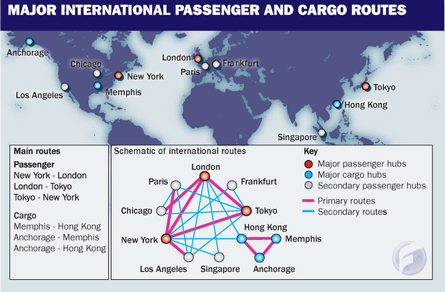As competition for space tourism heats up, a market projection for suborbital point-to-point (SPTP) transport has been published with a predicted seat cost of at least $70,000 and initial routes between London, New York and Tokyo.
A study by the US consultancy company Futron found that by 2020 space tourism could be a $700 million industry, but the SPTP market could be far larger.
"Its a very big, lucrative market. You're tapping into the wider transport market," says Futron senior analyst and suborbital space, Jeffrey Foust.
While there are no entrants for SPTP yet, the market for suborbital tourism has become more crowded with the announcement of a joint venture between NASA prize-winning rocket developer Armadillo Aerospace and the Rocket Racing company. Their two-person vertical take-off, vertical landing vehicle is planned to fly from 2010 from the same spaceport to be used by Virgin Galactic, Spaceport America in New Mexico.
 |
|---|
Virgin Galactic also aims to fly from Spaceport Sweden. Located near Sweden's arctic town of Kiruna, its operators also envisage an SPTP service.
The SPTP market study by Strasbourg-based International Space University (ISU) proposes a seven-passenger vehicle with a 12,000km (6,400nm) range connecting London, New York and Tokyo using a ricochet trajectory with a maximum altitude of 500km (310 miles).
DO NOT GO BALLISTIC
The 11,000km distance between New York and Tokyo rules out a ballistic trajectory, using the safe alttiude of 500km to avoid cosmic radiation exposure, because of the need to reach orbital velocities. A ricochet trajectory, however, would avoid such high speeds because it involves a vehicle accelerating, gaining altitude, slowing to re-enter the atmosphere briefly and then accelerating again. The ISU's dean, Walter Peeters, told Flight International: "With the ricochet it's constant acceleration, I think that could be quite uncomfortable and for that amount of money customers want a level of comfort. But it could be okay for people seeking adventure tourism." The study did find in favour of ballistic flights between 3,500km and 7,000km, with a London to New York trip taking just 28min.
While the London, New York, Tokyo triangle was determined from population growth projections for 2020, the report recommends that spaceports should be evolutions of existing airports, that for noise and safety considerations they should be coastal and that space vehicles' flights must be integrated into existing air traffic operations.
For international air traffic control, a new subdivision of the International Civil Aviation Organisation should be the rulemaking body. The ICAO oversight was first proposed by the International Association for the Advancement for Space Safety.
Coastal spaceports also avoid overland supersonic flight, as the ISU report says, "noise is a potential showstopper for suborbital transport".
Air traffic approach corridors must also be avoided to stop debris from vehicle disasters on ascent or descent colliding with passenger airliners.
STEEP DEVELOPMENT CURVE
Using NASA's technology readiness level (TRL) scale to evaluate available technologies, the ISU concludes that a suborbital transport vehicle is far closer to concept than reality.
Development would be expensive and in light of the current credit crunch the ISU recommends public-private partnerships, state defence funding, privately funded prizes and angel investors for financing. However, the study also found that small adjustments in cost factors, potentially driven by technological obstacles, resulted in a large variance in ticket prices, from $70,000 to up to $525,000 for a transatlantic trip.
Virgin Galactic president Will Whitehorn has talked of evolving his company's launch system for SPTP.
However, Foust, is not expecting SPTP anytime soon: "It requires new engines and thermal protection systems. It's another generation, two generations, before you get to that. The vehicles being developed today are straight up and down, a speed of Mach 3 with little cross range."
Source: Flight International


























